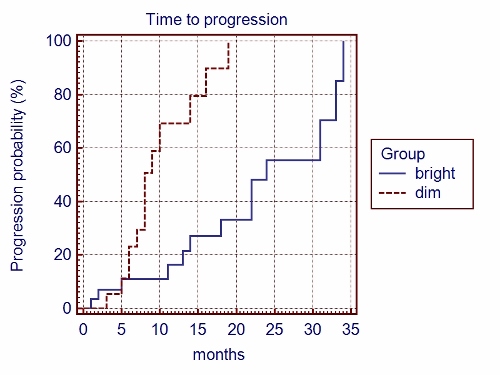Konference: 2013 18th Congress of the European Hematology Association - účast ČR
Kategorie: Mnohočetný myelom
Téma: Myeloma and other monoclonal gammapathies - Clinical
Číslo abstraktu: B1517
Autoři: MUDr. Alexandra Jungová; Mgr. Monika Holubová; prof. MUDr. Samuel Vokurka, Ph.D.; MUDr. Daniel Lysák; MUDr. Pavel Jindra, Ph.D.
Background:
Multiple myeloma is a disease characterized by the clonal proliferation of plasma cells with paraprotein production. Plasma cells usually have the specific immunophenotype CD38 +, 138 +, normal plasmocytes show a phenotype CD19+CD56-, while mature myeloma cells are CD19-CD56+. The surface antigen CD45 (protein tyrosin phosphatasis, receptor type C, PTPRC) normally expresses itself in young plasma cells. However, during the differenciation into mature plasma cells it goes down. The antigen-mediated signalization and activation of lymphocytes and plasma cells describe this character. CD45 negative cells are more resistant to apoptosis. According to the literature, there should be a low expression of the CD45 negative factor affecting the early progression of independent cytogenetic findings.
Aims:
To compare the time to progression / relapse on patients with multiple myeloma with regard to CD 45 expression.
Methods:
A retrospective analysis. Evaluated were samples from 71 patients with myeloma from 5/2011 to 12/2012. Cytogenetic risk by Avet-Loiseau, 2005: negative = normal karyotype, changes on chromosome 13 and 17, t (4; 14) at (14, 16), positive = everything else and t(11;14).
Flowcytometric analysis: using 8-color flow cytometry which detected the presence of plasma cells to using cytometer FACS Canto II.
Identification of plasma cells with sequential gating using a combination of the antigens CD38, CD138, CD45 and the scatter properties of plasma cells, the expression of antigens on atypical, atypical and normal plasma cells, positive control by CD138 +, negative control by CD8- with adjustment of the sequential gates, for the detection of MRD limit sensitivity 0, 01% (10 e-4).
Results: According to the intensity of the flow cytometric expression of CD45 two groups were defined; low expression "dim" and higher expression "bright". Group parameters were compared to “dim” (n = 25) vs. "bright" (n = 46): median age 58 years (38-69) vs. 62 years (40-72) (p = 0.30), male / female ratio 13/12 vs. 24/22 (p = 1.0), unfavorable cytogenetics 16/21 (76%), r. 25/42 (60%) (p = 0.26), not surveyed cytogenetics in 16% pts. vs 9% pts., the frequency of CR after the 1st line treatment 3/25 vs. 8/46 (p = 0.73), the frequency of autologous SCT in 1st line 23/25 (92%) vs. 38/46 (83%) (p=0,48). Living patients 21/25 (84%) vs 43/46 (93%), median follow up by living patients was 11 months (1-40), vs. 20 months (1-98), median of progression 8 vs. 22 months (p= 0,0003). The probability of progression at 24 months was 100% vs. 52% (p = 0.0003).
Image / Pictures:
Summary / Conclusion:
The effect of CD45 expression in comparison to the risk of progression on patients with myeloma was evaluated. We compared a group with low and higher CD 45 expression. There was no difference in the demographic parameters, cytogenetics risk or 1st line treatment. The group with a low expression of CD45 had a significant lower TTP and therefore a higher probability of early progression. A research over a longer period and a larger group of patients is necessary.
Keywords: CD45, Multiple myeloma
Datum přednesení příspěvku: 15. 6. 2013






